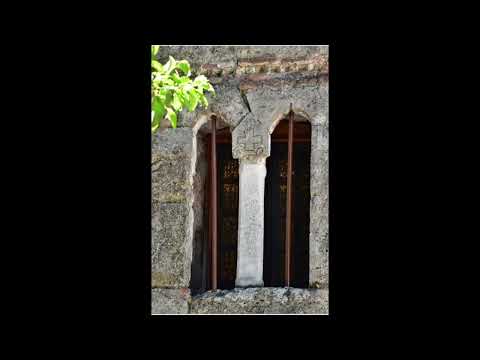filmov
tv
Τίμιος Πρόδρομος Βομβοκούς Ναυπακτίας Saint John Baptist Vomvokou Nafpaktia

Показать описание
Βρίσκεται 15 περίπου χιλιόμετρα βορειοανατολικά της Ναυπάκτου, σέ υψόμετρο 530 μ. κοντά στο χωριό της Βομβοκούς. Ιδρύθηκε πιθανότατα τον 11ο αι., αλλά δεν έχουν βρεθεί εμπεριστατωμένα ιστορικά στοιχεία. Ἡ τοπική όμως παράδοση διασώζει ὅτι ἡ αρχική Μονή είχε κτιστεί 500 περίπου μέτρα βορειοανατολικά του χωριού Σκάλα, στη θέση «Παλαιομονάστηρο», όπου και σήμερα ακόμη διατηρούνται ερείπια Ναού. Η εικόνα του Αγίου μετά την καταστροφή του πρώτου Μοναστηριού βρέθηκε με θαυματουργικό τρόπο στην απέναντι πλαγιὰ. Οι βοσκοί της περιοχής παρακινούμενοι από το έντονο φως που την περιέλαβε μέσα στη νύχτα, ανακάλυψαν την εικόνα μέσα σε σπήλαιο, στη θέση «στεφάνια», κοντὰ στη σημερινή Μονή. Επιπλέον, υπήρξε Σταυροπηγιακὴ μέχρι σχεδόν την Ἑλληνική Επανάσταση.
Το Καθολικό της Μονής οικοδομήθηκε το 1695 στη θέση παλαιότερου, απο τον 12ο αιώνα. Όσον αφορά την αρχιτεκτονική, είναι Ναὸς σταυροειδής τετρακίονος μὲ τρούλο. Χαρακτηριστικό του γνώρισμα -που παραπέμπει ίσως στην αλλοτινὴ σταυροπηγιακή του ιδιότητα και οπωσδήποτε δηλώνει βυζαντινή επίδραση- ειναι οι δύο αψίδες (βόρεια και νότια) με λειτουργική χρήση χορών κατά τον αγιορείτικο τύπο. Πανηγυρίζει τέλος στις 29 Αυγούστου (Αποτομή Τιμίας Κεφαλής) ,στις 24 Ιουνίου (Γενέσιο) , στις 7 Ιανουαρίου (Σύναξη), αλλά και στις 14 Σεπτεμβρίου (Ύψωση Τιμίου Σταυρού) , σύμφωνα με παλαιά συνήθεια.
It is located approximately 15 kilometers northeast of Nafpaktos, at an altitude of 530 m. near the village of Bombokou. It was probably founded in the 11th century, but no detailed historical evidence has been found. However, local tradition preserves that the original Monastery was built approximately 500 meters northeast of the village of Skala, in the "Paleomonastiro" location, where the ruins of the Temple are still preserved today. After the destruction of the first Monastery, the icon of the Saint was miraculously found on the opposite slope. The shepherds of the area, motivated by the bright light that surrounded it during the night, discovered the image in a cave, in the "stefania" position, near the current Monastery. In addition, it was Stavropegiak until almost the Greek Revolution.
The Katholicon of the Monastery was built in 1695 on the site of an older one, from the 12th century. As far as the architecture is concerned, it is a cruciform square church with a dome. Its characteristic feature - which perhaps refers to its former cruciform status and definitely indicates a Byzantine influence - is the two apses (north and south) with liturgical use of dances according to the Saints' type. It is finally celebrated on August 29 (Scapitation), June 24 (Genesis), January 7 (Synaxis), but also on September 14 (Elevation of the Holy Cross), according to old custom.
Το Καθολικό της Μονής οικοδομήθηκε το 1695 στη θέση παλαιότερου, απο τον 12ο αιώνα. Όσον αφορά την αρχιτεκτονική, είναι Ναὸς σταυροειδής τετρακίονος μὲ τρούλο. Χαρακτηριστικό του γνώρισμα -που παραπέμπει ίσως στην αλλοτινὴ σταυροπηγιακή του ιδιότητα και οπωσδήποτε δηλώνει βυζαντινή επίδραση- ειναι οι δύο αψίδες (βόρεια και νότια) με λειτουργική χρήση χορών κατά τον αγιορείτικο τύπο. Πανηγυρίζει τέλος στις 29 Αυγούστου (Αποτομή Τιμίας Κεφαλής) ,στις 24 Ιουνίου (Γενέσιο) , στις 7 Ιανουαρίου (Σύναξη), αλλά και στις 14 Σεπτεμβρίου (Ύψωση Τιμίου Σταυρού) , σύμφωνα με παλαιά συνήθεια.
It is located approximately 15 kilometers northeast of Nafpaktos, at an altitude of 530 m. near the village of Bombokou. It was probably founded in the 11th century, but no detailed historical evidence has been found. However, local tradition preserves that the original Monastery was built approximately 500 meters northeast of the village of Skala, in the "Paleomonastiro" location, where the ruins of the Temple are still preserved today. After the destruction of the first Monastery, the icon of the Saint was miraculously found on the opposite slope. The shepherds of the area, motivated by the bright light that surrounded it during the night, discovered the image in a cave, in the "stefania" position, near the current Monastery. In addition, it was Stavropegiak until almost the Greek Revolution.
The Katholicon of the Monastery was built in 1695 on the site of an older one, from the 12th century. As far as the architecture is concerned, it is a cruciform square church with a dome. Its characteristic feature - which perhaps refers to its former cruciform status and definitely indicates a Byzantine influence - is the two apses (north and south) with liturgical use of dances according to the Saints' type. It is finally celebrated on August 29 (Scapitation), June 24 (Genesis), January 7 (Synaxis), but also on September 14 (Elevation of the Holy Cross), according to old custom.
Комментарии
 0:00:00
0:00:00
 0:52:41
0:52:41
 0:57:34
0:57:34
 0:01:47
0:01:47
 0:10:14
0:10:14
 0:02:24
0:02:24